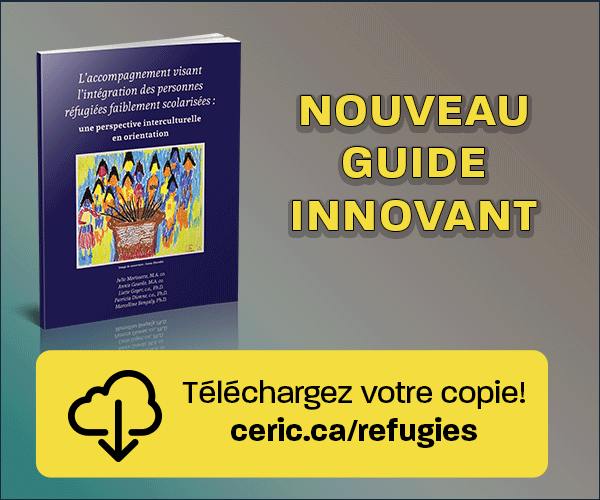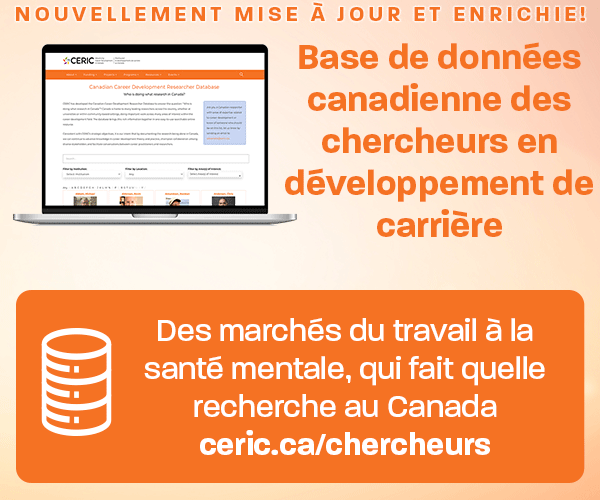Enquête sur les objectifs et les obstacles professionnels des mères adolescentes
Mots-clés :
objectifs professionnels, barrières, les mères adolescentes, adolescent, mèreRésumé
En raison des augmentations de la maternité auprès des adolescentes au Nouveau-Brunswick, il est impératif que leurs objectifs ainsi que leurs obstacles liés à leurs carrières soient examinés dans l’espoir d’un meilleur soutien. En utilisant l’approche qualitative, j’ai exploré les objectifs et les obstacles actuels/prévus liés à la carrière de trois mères adolescentes. Les résultats montrent que les objectifs liés à l’académique ainsi qu’à la carrière étaient variés entre chaque participante. Certains des obstacles communiqués inclus les contraintes financières et le manque de temps, le manque de soutien à la maison
(partenaire), le manque de qualifications, le manque de motivation à obtenir un diplôme secondaire, et une incertitude liée à le manque de conseil concernant l’éducation postsecondaire.
Références
Al-Sahab, B., Heifetz, M., Tamim, H., Bohr, Y., & Connolly, J. (2012). Prevalence and characteristics of teen motherhood in Canada. Maternal and Child Health Journal, 16, 228-234.
Barto, H., Lambert, S., & Brott, P. (2015). Career adaptability, resiliency and perceived obstacles in career development of adolescent mothers. The Professional Counselor, 5(1), 53-66.
Bielski, Z. (2013, January 29). Why teen pregnancy is on the rise again in Canada (and spiking in these provinces). The Globe and Mail. Retrieved from http://www.theglobeandmail.com/life/health-andfitness/health/why-teen-pregnancy-is-on-the-rise-again-in-canada-and-spiking-in-theseprovinces/article7927983/
Bissell, M. (2000). Socio-economic outcomes of teen pregnancy and parenthood: A review of the literature. Canadian Journal of Human Sex, 9, 191-204.
Brosh, J., Weigel, D., & Evans, W. (2009). Assessing the supports needed to help pregnant and parenting teens reach their education and career goals. Journal of Extension, 47(1), 1-7.
Business Community Anti-Poverty Initiative. (2006). Closing the gaps: Ensuring pregnant and parenting young women succeed. Retrieved from http://tamarackcommunity.ca/downloads/vc/SJ_Closing_Gap_june2906.pdf
Carlson, B. E. (1997). A stress and coping approach to intervention with abused women. Family Relations, 291-298.
Clemmens, D. (2003). Adolescent motherhood: A meta-synthesis of qualitative studies. MCN The American Journal of Maternal Child Nursing, 28, 93-99.
Connelly, F. M., & Clandinin, D. J. (1990). Stories of experience and narrative inquiry. Educational Researcher, 19, 2-14.
Connelly, F. M., & Clandinin, D. J. (2000). Narrative inquiry: Experience and story in qualitative research. Educational Researcher, 6, 94-118.
Creswell, J. W. (2012). Qualitative inquiry and research design. Thousand Oaks, CA: Sage Publications.
Creswell, J. W., Hanson, W. E., Plano, V. L. C., & Morales, A. (2007). Qualitative research designs: Selection and implementation. The Counseling
Psychologist, 35, 236-264. Dryburgh, H. (2000). Teenage pregnancy. Health Reports, 12(1), 9-19.
Hellerstedt, W. L. (2002). Economic, psychosocial, and health risks associated with adolescent childbearing. In M. Story & J. Stang (Eds.), Nutrition and the pregnant adolescent: A practical reference guide (pp.17-23). Minneapolis, MN: University of Minnesota.
Kennedy, A. C. (2005). Resilience among urban adolescent mothers living with violence: Listening to their stories. Violence Against Women, 11, 1490-1514.
Kennedy, A. C., & Bennett, L. (2006). Urban adolescent mothers exposed to community, family and partner violence: Is cumulative violence exposure a barrier to school performance and participation. Journal of Interpersonal Violence, 21, 750-773.
Klein, J. D. (2005). Adolescent pregnancy: Current trends and issues. Pediatrics, 116, 281-286.
MacGregor, C. A. (2009). Education delayed: Family structure and postnatal educational attainment. Retrieved from http://crcw.princeton.edu/workingpapers
Maple, M., & Edwards, H. (2010). Locating and understanding voices in narrative inquiry: A journey of discovery. In V. Minichiello & J. Kottler (Eds.) Qualitative journeys: Student and mentor experiences with research (pp. 33-48). Thousand Oaks, CA: Sage.
McKay, A. (2012). Trends in Canadian national and provincial/territorial teen pregnancy rates: 2001-2010. The Canadian Journal of Human Sexuality, 21, 161-175.
Miller, A. R. (2009). The effects of motherhood timing on career path. Journal of Population Economics, 24(3), 1071-1100.
Peterson, P., Baker, E., & McGaw, B. (2010). Narrative inquiry. In D. J. Clandinin & J. Huber (Eds.), International encyclopedia of education (pp. 436-441). Kidlington, OXON: Elsevier.
Phipps, M. G., Salak, J. R., Nunes, A. P., & Rosengard, C. (2011). Career aspirations and pregnancy intentions in pregnant teens. Journal of Pediatric and Adolescent Gynecology, 24(2), e11-e15.
Polkinghorne, D. E. (2007). Validity issues in narrative research. Qualitative Inquiry, 13, 471- 486.
Rothenberg, A., & Weissman, A. (2002). The development of programs for pregnancy and parenting teens. Social Work in Health Care, 35, 65-83.
Savickas, M. L. (2011). Career counseling. Washington, DC: American Psychological Association.
Smith, M. L., & Wilson, K. L. (2014). Employment status among parenting teenage mothers enrolled in high school. Journal of School Health, 84(9), 605-608.
Stiles A. S. (2005). Parenting needs, goals, and strategies of adolescent mothers. The American Journal of Maternal/Child Nursing, 30, 327-333.
Trahar, S. (2009). Beyond the story itself: Narrative inquiry and autoethnography in intercultural research in higher education. Forum Qualitative Social Research, 10(1), Art. 30.
Transition Houses for Abused Women. (n.d.). Retrieved from http://www2.gnb.ca/content/gnb/en/services/services_renderer.14436.Transition_Houses_for_Abused_Women.html
Tutty, L. M., Bidgood, B. A., & Rothery, M. A. (1993). Support groups for battered women: Research on their efficacy. Journal of Family Violence, 8(4), 325- 343.
Wengraf, T., & Chamberlayne, P. (2006). Interviewing for life histories, lived situations and experience: The biographic-narrative interpretive method (BNIM). A Short Guide to BNIM Interviewing and Practice. Retrieved from http://www.google.ca/url?sa=t&rct=j&q=&esrc=s&source=web&cd=5&ved=0CEAQFjAE&url=http%3A%2F%2Flearning-affordances. wikispaces.com%2Ffile%2Fview%2FBNIM%2BGUIDE%2B8-2bn%2Bshort.doc&ei=feApVK_5FJeAygTb7oGoBg&usg=AFQjCNEVjFwuxwYuWAT37g24jdQycvrHMg&sig2=42fb8M5p-UaDZ25bkjK8dw&bvm=bv.76247554,d.aWw
Zippay, A. (1995). Expanding employment skills and social networks among teen mothers: Case study of a mentor program. Child and Adolescent Social Work Journal, 12, 51-69.

Téléchargements
Publié-e
Comment citer
Numéro
Rubrique
Licence

Cette œuvre est sous licence Creative Commons Attribution - Pas d'Utilisation Commerciale - Pas de Modification 4.0 International.











